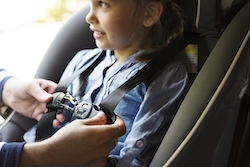Many Car Seats Are Installed or Operated Incorrectly by Parents

Car seats are designed to save young lives and prevent personal injury. Unfortunately, although most parents think they are installing the seats correctly, the National Highway Traffic Safety Administration (NHTSA) estimates that 46% of car and booster seats are misused! The consequences can be deadly, given that motor vehicle accidents are the number-one killer of kids in this country.
The Centers for Disease Control and Prevention (CDC) estimates that car seat use reduces the risk for injury in a crash by 71% to 82% for children. Booster seat use reduces the risk for serious injury by 45% for children ages 4 to 8 compared with seat belt use alone.
Avoid These Five Common Mistakes
Before you begin any car or booster seat installation, thoroughly read through the user’s manual. Familiarize yourself with all of the parts of your seat and keep the NHTSA tips for installation handy in case you need a refresher.
Mistake #1: Seat Too Loose
- Test it: Grab the car seat where the safety belt passes through the base. It’s too loose if you can move it more than one inch to the left, right, or forward.
- The danger: In a collision, a child in a loose seat could crash into the front seat and suffer severe head and face injuries.
- Fast fix: Add your weight and tighten the seat belt as much as possible. For forward-facing seats, also use the top tether to help lock the seat in place.
Mistake #2: Harness Too Loose
- Test it: Once the child is in the car seat, pinch the harness at the shoulder with the chest clip correctly in place. If you’re unable to pinch any excess webbing, it’s tight enough.
- The danger: A child can easily slip out of a loose harness or even be ejected from the vehicle, suffering severe injuries.
- Fast fix: Always use the chest clip, and position it level with the armpit. Make sure the harness passes through the proper slots and is tightly buckled. There should be no slack.
Mistake #3: Infant Turned Face Forward Too Soon
-
Test it: According to the American Academy of Pediatrics, all children should remain rear-facing at least until they turn 2 years old or have reached the maximum height or weight capacity of the infant car seat. Inspections show that 30% of infants are turned around too soon.
-
The danger: An infant’s bones and spinal cord are still forming. When a child is rear-facing, the most substantial part of her body – the back – can better absorb the immense forces of a crash. An infant’s relatively heavy head can catapult when facing forward, putting pressure on the undeveloped spine and risking paralysis or death.
-
Fast fix: Read the seat label and follow age and height/weight limits.
Mistake #4: Rear-Facing Infant Seat Not at a 45-Degree Angle
-
Test it: Many infant car seats have a built-in level that tells you when your seat is at the wrong angle. More often than not, seats are installed in a position that’s too upright.
-
The danger: An infant’s airway is as narrow as the diameter of a soda straw. If a rear-facing seat leans too far forward, the baby’s head can fall forward, cutting off her airway.
-
Fast fix: If your safety seat is not equipped with an adjustable pedestal to ensure the correct angle, tightly rolled-up towels or a section of a swimming pool noodle can be placed under the area where a baby’s feet rest.
Mistake #5: Not Knowing the Age Stages
- Test it: Any child between 40 and 80 pounds and up to 4’9” tall (generally kids from 4 to 8 years old) needs a booster seat. And children under 13 should never sit in the front seat.
- The danger: An adult seat belt doesn’t correctly restrain a child because it crosses the body at the wrong position: too high on the belly and across the shoulder. Plus, children often move the shoulder belt behind them because it’s uncomfortable. A child still too small for a seat belt can sustain internal, head, or spinal injuries during a crash.
- Fast fix: Move older children to a booster seat when they reach the height or weight limit allowed by the car seat manufacturer. Here’s a handy guide for choosing the right seat.